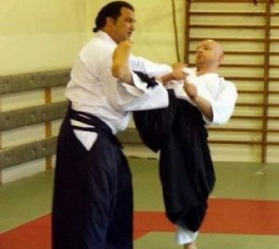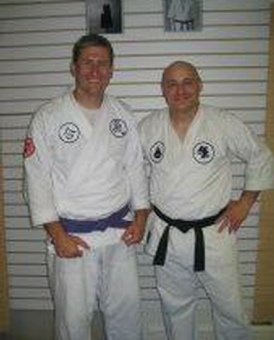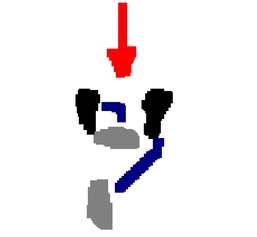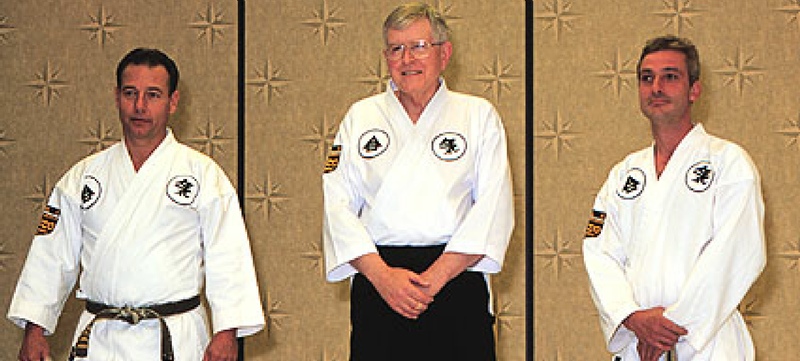

Inside Nihon Goshin Aikido #40 July 2016
Happy Independence Day Aikido Afficiandos!
I hope you are well. Personally, I'm
procrastinating. My mom has asked us to help her begin moving out of her house (on
Independence Day), and ~~~ 'Oh by the way, the air conditioner at the house is not
working ~~~ and it is supposed to be 100 degrees today." ~~~~ lol
As you might imagine,
motivation to help Mom is "not very high at the moment" ~ and while everyone else
in my family is moaning and complaining about the work ahead, I sought the refuge
of peace and endeavored to seek out more "fulfilling" notion. I'd already spent
the greater part of the day thinking on the sermon I heard in church on Ephesians
5 (check it out) the day before, so I went to the next best thing ~ Aikido. What
might I learn from the art today?
So as Providence would have it and while everyone
else was grumbling, I was watching Nihon Goshin Aikido videos on my smartphone. In
the process, I saw one of my Sensei's videos (which I had not seen before). His
topic was transitions, but before I share the video link, I wanted to provide a bit
of background information that might “set the stage” for a more thorough discussion
of the topic at hand.
Stage Setting: One of the most eloquent aspects of Nihon Goshin Aikido is the teaching pedagogy that makes up her form. “How we learn the system” ~ might be somewhat unique in its approach. Rather than dump the whole cirriculum on a new student, prototypical versions of techniques are divided into subsets so that 10 techniques are taught for each belt. While nearly all potential attacks are on the table from the first day, the techniques that the student will apply in a self defense scenario are limited. This is significant, as a limited “tool box” has a nice way of not overwhelming the student. It also leads to a “fast” competence for self defense.
One could argue that the most common attack is not a punch but a grip. Imagine someone grabbing your wrist while you're walking out of the Wal-Mart parking lot. As such, the new student can expect to learn the First Wrist Technique (a perfect technique to use as a defense against many grips) ~ and that technique only ~ possibly on their very first day of training. After the First Wrist Technique has been worked on and massaged into a basic level of proficiency over a few classes, the student's universe is widened and a new prototype of a technique is introduced; Perhaps the Elbow Chop ~ and that technique only.
By and by, all 10 techniques for yellow belt and a few applications (martial scenarios in which they might be used) for each of these 10 techniques are taught to the student.
After yellow belt, 10 more techniques and their various and sundry applications are added to the first 10 techniques and their applications. As the student continues to train, the building blocks of Nihon Goshin Aikido are gradually stacked one on top of another ~ until all 50 techniques with innumerable ways to use them all in martial scenarios are covered. It is an effective pedagogy, and even beginner and intermediate students become insanely competent at the “points” ~ to which they have been trained.
Generally, footwork options are minimized to a degree, and we strive to get to the point quickly. Our applications are taught to “mesh” with the Classical Techniques, and as a result ~ they are very direct:
Elbow Chop from a Straight Punch ~ Got it!
Arm Bar from a One Handed Push ~ Money!
Leg Sweep from a 2 Handed Choke ~ Sweet Sassy Molassee!
And on and on through all 50 techniques.
By a trick of fate, the 50th technique I learned was the Reverse Pivot Takedown and not the Scissors (which is usually the last technique a student learns in our dojo). Still, the order proved right for me, as the Reverse Pivot Take Down served a dual role in my cirriculum. The the technique was simultaneously the “end of the technique line,” but it is also marked the beginning of the “what if uke does this?” series of quesitons ~ which subsequenty opened up unlimited possibilities. It was with this understanding that I realized I'd never know “enough” about the art I aimed to master.
So let's get out our shovels and dig deeply, and return back to our original topic for discussion: “What if uke counters ~ which is the question introduced when the student learns “Reverse Pivot Takedown?” That is the theme of this edition of Inside Nihon Goshin Aikido. Let's see what the art has to offer our receptive minds today.
So, what if “uke does _________?”
This naturally instinctive question can not be asked enough, and if you spend any time watching a video from a Nihon Goshin Aikido attack line (like my old Sho-Dan test which is posted on youtube), you'll probably see a few defenses where correctly performed technique breaks down ~ because an awkard relationship exists between nage and uke. In other words, nage does a technique, but uke doesn't “cooperate” ~ often as a result of uke simply trying to protect himself ~ and now we lose our template for action ~ because nothing is where it is supposted to be. What happens next can be “ugly” ~ sometimes referred to in our dojo as “the HurrTicane” (pronounced “Hurt-A-Cane”) Think “Hurricane” but add a T in the middle.
“The HurrTicane” is devolved aikido in which nage is confused by uke's position relative to himself and subsequently struggles to defend using clearly defined aikido principles. As a result, uke is typically endangered in some way as strength, aggressive joint locking, and sheer force of will take over. Predictably, ugly, marginally effective, aikido is the typical result.
Considering the “what if uke does this?” possibility is therefore extremely valuable to the senior and junior student alike ~ as avoiding HurTicane scenarios in the dojo and on the street is paramount. That said, rather than explore transitions myself ~ which everyone does to some degree or another ~ I often have better results working within a predefined structure used to guide a series of logical responses.
So, with all the ground work now laid in front of us, here is the link to Sensei Carter's youtube video on counters and combinations to uke's willful or lucky defenses. His martial presence allows him to proceed in a consistent, “aikido” mindset from beginning ot end ~ as uke “counters.” (https://www.youtube.com/watch?v=Y09fsnP5_L4)
Beginning @ 1:57 ~ uke demonstrates a rudimentary, but effective counter to nage's application of technique. The sequence runs as follows: Uke attacks with a 2 hand choke => Nage responds with an Elbow Chop => Uke Counters by taking a big step to maintain his base and avoid the fall => Nage utilizes an Unbendable Arm principle to control uke's head and buy some time => Nage executes a Wheel Throw to complete the defense.
In my mind this an example of what you see when you look into the Pandora's Box that the Reverse Pivot Takedown naturally opens. We call it “ura” (turn) is as in a “Transition Game" ~ where techniques (individually taught as A, B, C, and D) begin to get linked together in a martially sound, fluid (ABCD, DBAC, DCBA, etc.) kata which transitions seamlessly through a few techniques due to uke's defensive response, etc. (A: Uke Attack B: Nage Technique C: Uke Counter D: Nage Technique to Finish). The benefit of running through these types of scenarios is that eventually you can devise and/or improvise sound martial adaptations to all potential counters using a series of templates like this one; when you happen to find yourself out of “whack.”
Now in all fairness, ~ the fluid counter game is where the advanced student naturally wants to practice all the time. But be warned, practicing here exclusively may be unwise as without a regular reveiw of all the art's component parts, one might find it impossible to do the fluid kata with any precision, or worse yet, one might begin to omit techniques within the art itself!
In a telling interview with Sensei James Durand (link here: http://www.ngaexperience.com/jamesdurandinterview.html ), I asked him, “What is your favorite technique in Nihon Goshin Aikido?” Sensei Durand, wisely countered, “Probably the more suitable question would be: “What technique is your least favorite or the one that never seems to pop out under pressure?' Now the answer to that question is the technique or techniques that need the most work ~ and also the ones we are most neglecting.”
So this the delicate balance we aim to secure, and in our efforts to master every tree in the forest of Nihon Goshin Aikido, let us not forget that we are still working in a forest, and vice versa.
Thoughts? What say ye?
Vacation Report:
June 17-24, my family and I went to Orlando Florida for a volleyball tournament in which my daughter was participating. The trip doubled as a family vacation in addition to a volleyball tournament.
Notes from the trip. Most notably, Orlando is a weird place. I kept expecting to see the ocean, but it never showed up ~ because Orlando is in the middle of Florida ~ so you get all the humidity, and none of the beach! Still water is always nearby. Unfortunately, these bodies of water, are nearly always filled with alligators. So it turns out that water is “just for show” in Orlando.
Other Vacation Observations (Tourist Attractions):
The Kennedy Space Center is completely worth the money we spent to visit the operation. I could easily spend 3 days there ~ and my family would gladly join me in the venture. Did you know the Saturn V rocket ~ the rocket design they used to go to the moon ~ (built in the 1960s) is still the most powerful rocket engine ever designed?
“Went -N-Wild is the name of a water park in Orlando. It is awesome. This is one of the few places you can go in Orlando that features water, but no alligators. There are at least 10 rides that you would want to ride multiple times. Fair Warning: Brazilian guests to the park ~ with their lack of an understanding for American bathing suit dress codes ~ will make for some very awkward moments. To the three Brazilian ladies ( mom and two daughters) who decided it would be okay to completely take off their bikini tops to adjust the straps while in line to ride “The Storm” ~ well generally speaking ~ that kind of activity is frowned upon in American establishments. Also, for the record, and though I wish it were not the case, my 10 and 15 year old sons will never forget you.
Disney World ~~~ How can I say it? Well, in my mind, Disney World is not worth the money you would spend to attend the venue at any price point. My wife's brother works for Disney, so we all got in free. Despite the free admission, I still felt like I'd been ripped off. I'm not sure I can find a redeeming thing to say about the Magic Kingdom. Sorry Mickey ~ but your park is a bust.
Aikido in Orlando: A bright spot in the trip! There are a lot of cool Aikido training venues in Orlando. Simply googling “Aikido Orlando, Florida” will bring up a range of possbile training sites, but I settled on the Aikitenshi Dojo. Their style of Aikdio is called “Mukei No Ryu Aikido,” or “style transcending form” Aikido. One of the main reasons I visited this dojo and not the others was because of Jose Andrade’s, the chief instructor, trained under Mr. Bowe in the 1960s, and because I had seen Sensei Andrade's videos on youtube, and had even previously linked to one of these videos on ngaexperience.com (http://www.ngaexperience.com/brownandblackapps.html (look at the link bottom left)
If I had the opportunity to do some aikido training, this was the place I was going to do it, I just needed an opportunity. I sent an email introduction to the email address listed on the website asking for permission to join in on a class, and provided information about my training background in Nihon Goshin Aikido, etc. Sensei David Parker responded with instructions as to class times, mat fees, etc.
The following day, I found an opportunity to train in both the morning and in the evening sessions.
Let me tell you about the experience, as it gels nicely with the discussion we were having regarding transitions and the counter game we were discussing earlier. One of the most interesting aspects of this aikido experience is that it was all devoted to transition training. I've attached a video featuring the instructor I trained with (Sensei David Parker ~ who is the
full time instructor at the dojo) ~ and the types of things we were doing in the morning and
evening sessions on the day I trained with him (note the connection of the dots between counters and also styles. In nearly every scenario there was a seamless transtion not only between uke and nage but also between Aikido and jujitsu/judo). Throughout the day we probably did 10 - 15 different variations of scenarios like the one highlighted in the video where the formula went: Uke presents a Street Attack => Nage performs an Aikido Technique => Uke Counters => Nage Counters & Submits (typically to
ground). I found the synthesis of standing aikido with grappling and ground fighting compelling.
Because we offer the Gracie Combatives Cirriculum at our dojo, I wasn't lost, but training the two arts simultaneously was new to me. I believe blending the two ideas together presents a logical fighting style. With this idea, you follow the fight where the fight takes you. Aikido standing = Aikido on the ground. The more I learn about it, the more I see that the only difference between these two styles is “altitude.” Where the fight occurs is irrelevant to the principles behind the movements.
Check out the video sample to get a feel for what we were doing.
https://www.youtube.com/watch?v=2190Jsyzj00
Finally, as you all know, I'm somewhat tatami obsessed, and my report would not be complete without a detailed assessment of their training mat. So here goes: The tatami at the Akitenshi Aikido Dojo was a green one piece high school wrestling mat laid out on top of a plywood frame of some thickness. The mat itself was a bit "sticky" as all wrestling mats are ~ but it was awesome.
The shomen, which you can see to the right of the action in the early part of the video with Sensei Parker, is the grandest shomen I've ever seen. It must have cost a few thousand dollars at least. If anything, it looked like a piece of high end furniture (made out of an exotic wood ~ perhaps Cherry) ~ and was about 10 feet tall. The border around the mat used the same wood, and maintained the sasme quality craftmanship. Serious money was dropped into that dojo to create a unique and dare I say it, “reverent,” training experience. If you are ever in Orlando with Gi in hand (and you should always have gi in hand when you travel), email Sensei Parker and ask to take a class or two. You will be glad you did.
So ~ August is next (where did my Summer go?!), and in the August edition of Inside Nihon Goshin Aikido, I will be discussing Gun Defenses. Now I'm normally not a man to place a wager, but I bet you a dollar you are not thinking about the gun defenses I'm thinking about. Ahhh the suspense of it all!
Let's meet together on the mat, and soon.
Jonathan Wilson
Ngaexperience.com

2014 - 2021 ngaexperience.com

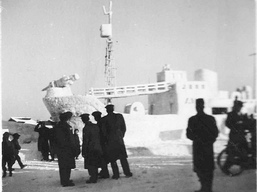

Seagal Knows The Scoop Against The Kick?
Click Here to Read Our Analysis of Taka Sensei (Steven Seagal’s) Aikido
